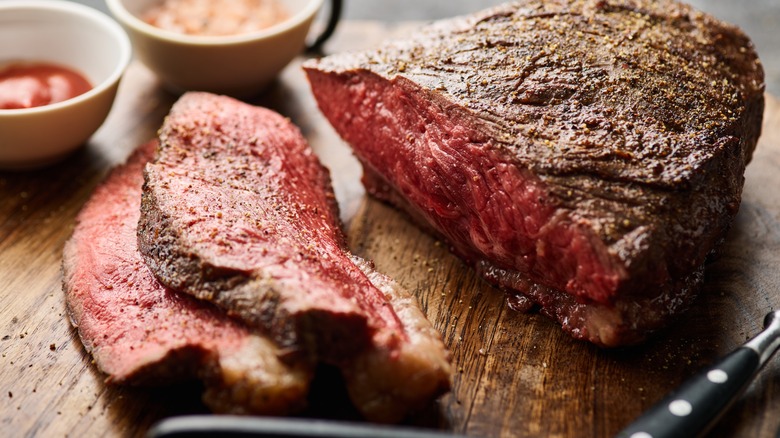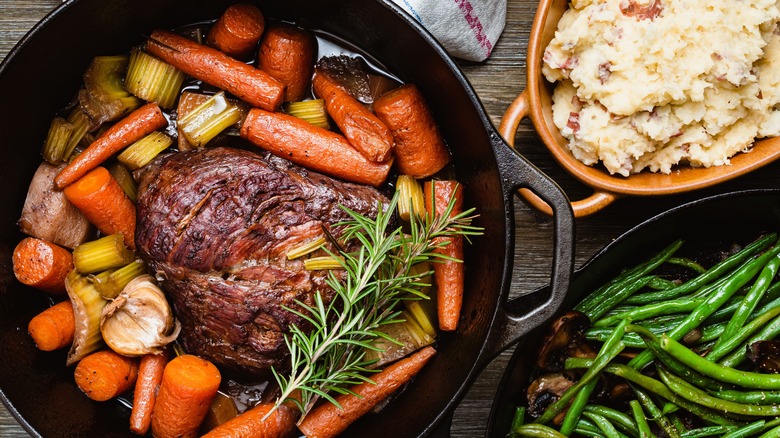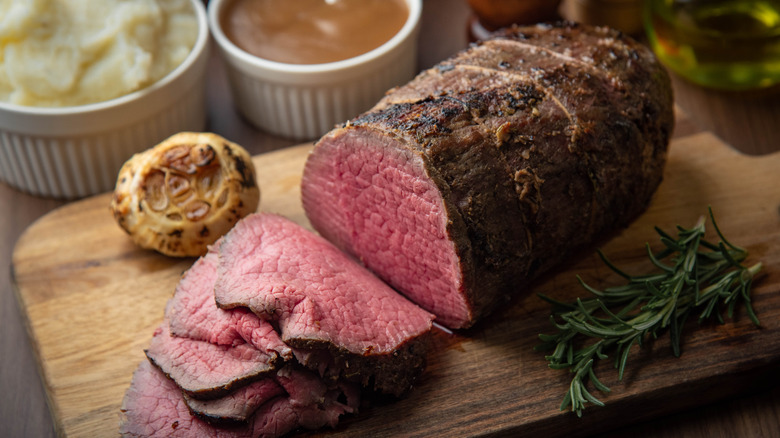The Flavorful Difference Between Rump Roast And Bottom Round Steak
For the uninitiated, navigating the many different cuts of beef at a grocery store can be as complicated as finding the Ark of the Covenant. Most people are familiar with the various loin cuts found on steakhouse menus, but these often prove cost-prohibitive. This is because the muscle in that area does a lot less work than the weight-bearing sections like the round, resulting in a tender cut. However, round cuts can be just as delicious and tender if they are chosen and prepared properly.
The round of the cow is its tail end, comprising the strong back leg muscles. It comes in various cuts — top round, bottom round, and eye round — that have very little fat compared to the loins, which can make for a tough steak when cooked. The very top of the round, from the end of the loin to the tail, is called the rump, hence the name. While still technically part of the round, the rump does have more fat than the lower cuts.
Fat is a key part of a meat's flavor and tenderness; the more, the better. So, while both these cuts are classified as extra lean, the rump's relatively higher fat levels make for a slightly better-tasting cut.
A rump roast is perfect for braising and stewing
Even with a lower fat content, a rump roast can be incredible if cooked the right way. One of the added benefits of its larger muscle connective tissue is a high concentration of collagen. This protein is particularly strong, but it is soluble in water. When the rump roast is either braised or stewed, the moisture from these cooking methods breaks down the collagen, turning it into gelatin. This creates a flavor bomb in the meat while smoothing out the texture.
All beef experts know that time is the key factor to the best pot roast. Most recipes require a minimum of four hours of cooking time, as the collagen of the meat starts breaking down at 160 degrees Fahrenheit. It is also common to use wine as a braising liquid, as it will impart its flavors into the meat, and its natural acidity will assist in the denaturation process, further breaking down proteins for a softer bite.
Thinly slice and marinate bottom round steak
Similar to a rump roast, a bottom round roast makes for a great pot roast and stands up well to other kinds of braising, such as in the Italian dish that combines steak with leftover pizza sauce, carne alla pizzaiola. However, it also responds well to marination. Allowing the meat to sit for an hour in wine, or a basic marinade of soy sauce, vinegar, lemon juice, and a variety of spices, softens up the muscle-heavy meat and ultimately cuts down on cooking time. If bottom round steaks are on the menu, the thinner the better. The longer the meat is exposed to heat, the more likely it will end up tough.
Speaking of thin, a bottom round roast also makes excellent deli-style roast beef, perfect for sandwiches. After the roast is seared and slow-cooked, place it in the refrigerator and let it cool for about an hour. Using an electric carving knife, slice the roast as thin as possible. Either served cold with horseradish on rye or warmed up with gravy on a hoagie roll, the results are going to be delicious.



